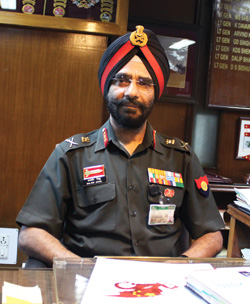INDIAN ARMED FORCES CHIEFS ON
OUR RELENTLESS AND FOCUSED PUBLISHING EFFORTS

SP Guide Publications puts forth a well compiled articulation of issues, pursuits and accomplishments of the Indian Army, over the years

I am confident that SP Guide Publications would continue to inform, inspire and influence.

My compliments to SP Guide Publications for informative and credible reportage on contemporary aerospace issues over the past six decades.
- Prime Minister witnesses 'Bharat Shakti' – a Tri-Services Firing and Manoeuvre Exercise in Pokhran, Rajasthan
- Interim Defence Budget 2024-25 — An Analysis
- Union Defence budget 2024
- Prime Minister Modi Commemorates Indian Navy Day in a Grand Ceremony
- Prime Minister Modi Flies in the LCA Tejas
- New Chapter in India-Italy Defence Ties
- Airpower beyond Boundaries
‘I visualise a broader mandate for the Mechanised Forces in the future’
In an exclusive Interview with SP’s M.A.I., Lt General D.S. Siddhu, Director General Mechanised Forces, flags the modernisation and upgrading efforts of the Mechanised Forces of the Indian Army.

SP’s M.A.I. (SP’s): In the context of the future threats and challenges, have any new roles been defined for the Armoured Corps and the Mechanised Infantry?
Lt General D.S. Siddhu (DGMF): The security environment facing our nation is in a state of constant flux. There is a need for close monitoring of the changes taking place within and outside, especially in our close neighbourhood. We are constantly reviewing our military preparedness based on these changes. The Mechanised Forces need to constantly evolve, develop and adapt to the changing “capability cum threat” spectrum, in order to remain ‘operationally relevant’ at all points of time and to maintain the deterrence value.
I visualise a broader mandate for the Mechanised Forces in the future. We are likely to be employed in a broad spectrum of operational scenarios, ranging from operations in amphibious and mountainous terrain to various overseas deployments as part of an UN mandate. In addition, ever growing urbanisation has resulted in the likelihood of being involved in urban warfare and resultant consolidation operations.
SP’s: What are the basic parameters which you consider essential and vital for designing the future MBT of the India Army?
DGMF: Based on the operational requirements, perspective planning and technologies available at present as well as in the future, the basic contours and the road map of the futuristic main battle tank (FMBT) have emerged. The preliminary staff qualitative requirement (PSQR) for the FMBT is evolved after taking the views of all the stakeholders. The efforts towards indigenisation/ absorption of transfer of technologies (ToT) and the lessons learnt play a major part in development of the FMBT.
SP’s: What is the current status of procurement of light tank for the Indian Army?
DGMF: The relevance of armour has expanded from the erstwhile manoeuvre warfare to operations in difficult terrain, amphibious operations and fourth generation warfare. Consequently, a need has been felt to customise our equipment profile to meet the specialised requirement. To that effect, the light tank is being proposed to meet different operational requirements. Currently, doctrinal and technical issues are being deliberated. Thereafter, the qualitative requirements will be finalised.
SP’s: Has any new equipment been planned for the reconnaissance troops and platoons of armoured regiments and mechanised infantry battalions respectively to make them more effective?
DGMF: The Indian Army is looking at the procurement of a light armoured vehicle designed to meet the requirements of the reconnaissance troops and platoons. This vehicle will have the required mobility and agility over all types of terrain as also survivability, it will be equipped to carry out reconnaissance tasks during day as well as night in all weather conditions. Electronic control displays will integrate all on board systems for ease of management and efficiency.
SP’s: Russians have made the ICV BMP-3 which has a 100mm 2A70 semi-automatic rifled gun as its main armament fires an anti-tank guided missile from the same barrel. Is the IA planning for a future ICV on this pattern?
DGMF: BMP-3 though a versatile equipment, but its physical attributes impinge on its deployment and floatation capability. Indian Army has planned for a futuristic infantry combat vehicle (FICV) to replace the BMP-2 with key operational and performance parameters envisaged in the Indian context. The project is a pioneer in ‘Make Hi-Tech’ category where for the first time the defence industry has invited participation by private established agencies. The project is in an advance stage for development of a prototype. We are of the view that our operational requirements can be met with a weapon mix of a cannon, machine gun, missile firing capability and an automatic grenade launcher.





